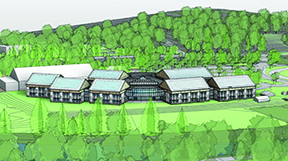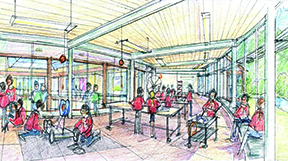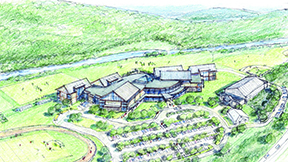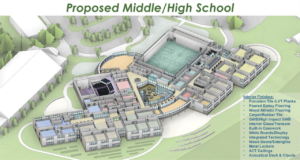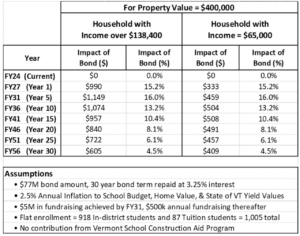Voters will be asked to approve bond in March
By Polly Mikula
Voters in seven towns will be asked to approve an $80+ million project to build a new district middle/high school adjacent to the current structures in Woodstock at Town Meeting Day this March.
“Slated to open in September 2026, pending voter approval, the new middle and high school campus will support collaboration, creativity, and critical thinking in our students,” states the Mountain Views Supervisory Union (MVSU) on its webpage mtnviews.org/breaking-new-ground.
Woodstock middle school and high school educate students from the district towns of Barnard, Bridgewater, Killington, Plymouth, Pomfret, Reading and Woodstock.
“The facilities are woefully out of date,” said Bob Hager, a 1956 graduate of Woodstock High in a video entitled “Breaking Ground” on the district’s site. “There are some building systems at risk of imminent failure.”
Over the past few years, the school district has been forced to make costly, patchwork repairs that don’t solve the problems long term. Last year, the building’s heating system degraded to the point where the district lost the use of six classrooms and emergency upgrades cost taxpayers $1.2 million, according to the district site.
“The list of expensive repairs needed continues to grow, I think the estimate is around $20-$22 million now, if we were to fix all the major repairs needed,” said WUHS/MS New Build Working Group Chair Ben Ford at the district board meeting, Monday, Sept. 11. “And those are only the ones currently broken,” he added.
“We’ve really pushed this facility as far as we can,” echoed Garon Smail, principal at Woodstock middle/high school in the online video.
According to a 2022 study by the Vermont Dept. of Education, Woodstock’s facilities were ranked the second worst in the state for their physical condition. The study cited many systems failing, including the heating, windows, roof, electrical and plumbing. “This has caused inadequate ventilation, poor acoustics, substandard accessibility, and insufficient safety standards, which have presented significant obstacles to learning and potential health concerns,” the report concluded.
“Our systems in the building here are extremely dated and obsolete,” said Joe Rigoli, district building and grounds manager in the video online. “We’re at the point where most of our systems are beyond repair and are in need of replacement.”
To address those challenges, a facilities analysis and master planning process began in 2016 with input from faculty, staff, students, school board and community members. Over a period of four years, it weighed the cost of renovating vs. building new and concluded that a new facility “would provide the best value.”
“In addition to being more expensive and infeasible, renovation would have a far greater impact on students who would be displaced and disrupted for two to three years while attending school amidst construction,” the district committee stated. “For these reasons and following a facility assessment and options analysis, our school board determined that a new school building is the right choice for our district.”
The new school will be on a different site, located adjacent to the current school building, so classes will continue in the old building until the new building is ready.
Plans for the new build
The architectural plans for the new middle school/high school call for a two-story 163,000-square-foot building with a capacity for 700 students. Last year, the district had 444 students in grades 7-12 at the middle/high school; the average from 2003-2020 was 555 students. (Current enrollment numbers for the 2023-24 school year will not be available for about 10 more days, Raphael Adamek, director of technology and innovation, told the district board at the meeting Monday.)
Some demographic models predict continued growth in the Killington and Woodstock, but current district estimates remain modest at 10 additional students per year.
The new building will allow for enrollment growth and offer about 35,000 square feet of more space than the current school buildings — that additional space is all vertical, Ford explained, as the school is required to keep its same footprint due to state river corridor constraints.
The new design is “net-zero ready” with energy-efficient systems and air quality control to ensure a healthy environment for students and staff; and it is ADA compliant to ensure accessibility for all.
Plans also include a state-of-the-art performing arts center; a natural light-filled atrium; a greenhouse; classrooms designed for collaborative learning and innovative teaching methods, such as flexible classrooms and maker spaces; and enhanced fire suppression systems and school security.
Citing studies from the Harvard T.H. Chan School of Public Health the district stated: “Healthy school buildings and modern design for educational facilities improve student well-being and in turn, student performance, test scores, behavior, and graduation rates.”
Timeline
On Town Meeting Day this past March 2023, voters approved $1.65 million to fund project planning and permitting.
On Town Meeting Day this coming March 2024, voters will be asked to approve the bonds for the construction of the new building and demolition of the old building. A majority of voters across all member towns will be required to move the project forward.
If that bond vote is successful, it is estimated that a new school can be constructed in 18 months — a quick timeline especially given that the district will have to complete necessary permits including Act 250. The district says the building could be open for the start of school in the fall of 2026.
Construction management, estimating cost
At the board meeting Monday, Sept. 13, three bids for construction management of the project were opened. DEW Construction of Williston came in with the lowest bid at $5,109,016; followed by PC Construction of South Burlington at $8,930,131, then Whiting-Turner of Springfield, Massachusetts at $9,044,793. While the board is required by state statute to choose the lowest qualified bid, they chose not to vote to accept DEW’s bid at the meeting Monday and instead have qualified personnel compare the details of the bids to ensure an “apples to apples” comparison. The board will vote to award the bid at its next meeting, Oct. 2.
The chosen construction management firm will then work hand-in-hand with project architects Lavallee Brensinger of Boston, Mass., and Manchester, New Hampshire, to complete the design, site planning, and cost estimating for the new high and middle school building such that up-to-date and accurate costs and plans can be brought before voters well before the March vote.
How does the cost compare to similar new school projects?
Based on the current projections of $80 million, the cost breaks down to $513 per square foot. By comparison, the average cost per square foot of five new public middle or high school projects planned for bid in Massachusetts in 2024 of similar size is approximately $730/square foot, according to the district’s FAQ page. In New Hampshire and Maine it’s approximately $520/square foot.
“This puts our project squarely in the average cost of building a new middle and high school in our region,” the district states.
“To use a common metaphor, if the new building were a car, it would be a Subaru—practical, efficient, durable and economical,” the district site states.
What will it cost me?
The money for the new building will come from three sources: borrowing (voter approved bond), grant/incentive programs, and private fundraising.
Only the bond will affect taxpayers. But not all taxpayers will be affected the same. Property taxes on primary residences, called “homestead” property, in the school district will be impacted by the school bond payments. Taxes on second homeowners and business property, called “non-homestead” property are set by the Legislature at statewide rates and will not be directly impacted.
However, most homeowners —70% in Vermont—receive a property tax credit reducing the property tax owed proportionally based on their income. Only those earning over $134,800 do not, according to a January 2023 report “Education Finance in Vermont” by Julia Richter, fiscal analyst, Joint Fiscal Office, House Committee on Ways and Means.
Additionally, about 30% of those homesteads eligible for income sensitivity are also eligible for a homeowner rebate, further decreasing their true educational property tax burden.
Thus, only the minority (30%) of homeowners (those earning over $134,800/household) are actually on the hook for the full increase to local property taxes; the impact will be less for those earning less — Vermont’s complex tax equations are aimed to make taxes more fair, but they also make them much harder to understand.
In an effort to approximate true cost for various income levels, the district created a chart (see it below left).
Ways to reduce the bonded debt
For most, there will likely be some increase to the tax rate in the immediate future. Ford showed various scenarios to the board Monday; explaining how the tax rate would change over time under various scenarios, including: enrollment changes (more students decrease tax rates, fewer students increase them); fundraising/grants; and bond structures/terms.
Ford reported that private fundraising is “well underway with $3.2 million raised to date.” The new build committee has set a 5-year goal of $10 million and a 10-year goal of $20 million — or about $500,000 per year, he explained.
However, based on Ford’s models, increasing enrollment is the most significant factor in determining education tax rates. Increasing the number of students enrolled, will immediately drive tax rates down, Ford explained.
“In fact, increasing district enrollment to 1,200—a number of students our district has had as recently as 2006—would completely offset the cost of building the new school. Further increases in enrollment would drive tax rates below current levels,” Ford said, adding that while he is not projecting taxes will decrease in the near future, he wouldn’t be surprised if the draw of a new facility could be greater than expected.
Conversely, if the district saw student attrition (perhaps because its facilities continued to decline), it would result in a raise in the “Per Pupil Spend” and lead to higher tax rates. If in-district enrollment declined to 800 students, the resulting tax rates will be higher than building the new school with none of the benefits, Ford calculated.
Additionally, last school year, the district board passed policy to limit the tax impact of the new build to a 16% cap.
“That was the impact to Burlington taxpayers who in 2022 passed a $165 million bond for the construction of a new high school building with 76% voter support,” Ford said.
This “cap protection” represents a roughly 50/50 split between district taxpayers and other funding sources, according to the district website.
If the district is unable to meet the 16% tax impact cap through other means, reductions to the school budget may be required to make the school project affordable to district taxpayers, Ford explained. “Taxpayers have the ability to hold the district accountable each year by approving the school district budget… if we violate our own policy, I wouldn’t blame them,” he said.
Ford summarized. “Investing in our facilities up front is the smart thing to do. Initially, it will cost more than limping our current facilities along, but over time will save taxpayers money any way you look at it… we need to ask ourselves, where do we want to be in 10 years? and make the right choice for our students and our community. The current building is already 20 years past its lifespan.”
What’s next?
“We were out on The Green last Wednesday talking to droves of people coming up to learn about the new build plans,” Ford said. “People were very supportive, had good questions and even those who didn’t know anything about the plans seem to understand the need.”
“Last March when voters approved the $1.65 million, was a turning point,” he said. “I think most people in our communities will support this important investment once they understand the choices we face as a district.”
Ford said the new build committee will meet again later this month and will discuss plans to get out to all of the district towns to help answer any questions and concerns residents may have. Public information meetings will be held in December when true costs and designs are finalized.
For more info about the new middle school and high school plans, visit: mtnviews.org/breaking-new-ground.
